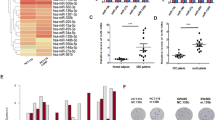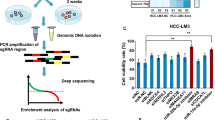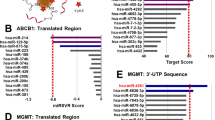Abstract
Multidrug resistance (MDR) is usually correlated with the poor prognosis of gastric cancer. In this study, we revealed a total of 11 microRNAs (miRNA) that regulated MDR of gastric cancer via high-throughput functional screening, and miR-508-5p reversed MDR most efficiently among these candidate miRNAs. The overexpression of miR-508-5p was sufficient to reverse cancer cell resistance to multiple chemotherapeutics in vitro and sensitize tumours to chemotherapy in vivo. Further studies showed that miR-508-5p could directly target the 3′-untranslated regions of ABCB1 and Zinc ribbon domain-containing 1 (ZNRD1), and suppress their expression at the mRNA and protein levels. Meanwhile, the suppression of ZNRD1 led to a decrease in ABCB1. These findings suggest that a miR-508-5p/ZNRD1/ABCB1 regulatory loop has a critical role in MDR in gastric cancer. In addition, miR-508-5p could be used as a prognostic factor for overall survival in gastric cancer. These data reveal an important role for miR-508-5p in the regulation of MDR in gastric cancer, and suggest the potential application of miR-508-5p in drug resistance prediction and treatment.
This is a preview of subscription content, access via your institution
Access options
Subscribe to this journal
Receive 50 print issues and online access
$259.00 per year
only $5.18 per issue
Buy this article
- Purchase on Springer Link
- Instant access to full article PDF
Prices may be subject to local taxes which are calculated during checkout







Similar content being viewed by others
References
Jemal A, Siegel R, Xu J, Ward E . Cancer statistics, 2010. CA Cancer J Clin 2010; 60: 277–300.
Fodale V, Pierobon M, Liotta L, Petricoin E . Mechanism of cell adaptation: when and how do cancer cells develop chemoresistance? Cancer J 2011; 17: 89–95.
Galluzzi L, Senovilla L, Vitale I, Michels J, Martins I, Kepp O et al. Molecular mechanisms of cisplatin resistance. Oncogene 2012; 31: 1869–1883.
Hendrikx JJ, Lagas JS, Rosing H, Schellens JH, Beijnen JH, Schinkel AH . P-glycoprotein and cytochrome P450 3A act together in restricting the oral bioavailability of paclitaxel. Int J Cancer 2012; 132: 2439–2447.
Zhu H, Liu Z, Tang L, Liu J, Zhou M, Xie F et al. Reversal of P-gp and MRP1-mediated multidrug resistance by H6, a gypenoside aglycon from Gynostemma pentaphyllum, in vincristine-resistant human oral cancer (KB/VCR) cells. Eur J Pharmacol 2012; 696: 43–53.
Tsuji K, Wang YH, Takanashi M, Odajima T, Lee GA, Sugimori H et al. Overexpression of lung resistance-related protein and P-glycoprotein and response to induction chemotherapy in acute myelogenous leukemia. Hematol Rep 2012; 4: e18.
Han JY, Hong EK, Choi BG, Park JN, Kim KW, Kang JH et al. Death receptor 5 and Bcl-2 protein expression as predictors of tumor response to gemcitabine and cisplatin in patients with advanced non-small-cell lung cancer. Med Oncol 2003; 20: 355–362.
Michaud WA, Nichols AC, Mroz EA, Faquin WC, Clark JR, Begum S et al. Bcl-2 blocks cisplatin-induced apoptosis and predicts poor outcome following chemoradiation treatment in advanced oropharyngeal squamous cell carcinoma. Clin Cancer Res 2009; 15: 1645–1654.
Williams J, Lucas PC, Griffith KA, Choi M, Fogoros S, Hu YY et al. Expression of Bcl-xL in ovarian carcinoma is associated with chemoresistance and recurrent disease. Gynecol Oncol 2005; 96: 287–295.
Vousden KH, Lane DP . p53 in health and disease. Nat Rev Mol Cell Biol 2007; 8: 275–283.
Plenchette S, Cheung HH, Fong WG, LaCasse EC, Korneluk RG . The role of XAF1 in cancer. Curr Opin Investig Drugs 2007; 8: 469–476.
Guo W, Zhao YP, Jiang YG, Wang RW, Hong L, Fan DM . Upregulation of ZNRD1 enhances cisplatin resistance in human esophageal cancer cells by regulation of ERCC1 and Bcl-2. Tumour Biol 2008; 29: 188–194.
Hong L, Qiao T, Han Y, Han S, Zhang X, Lin T et al. ZNRD1 mediates resistance of gastric cancer cells to methotrexate by regulation of IMPDH2 and Bcl-2. Biochem Cell Biol 2006; 84: 199–206.
Zhao L, Pan Y, Gang Y, Wang H, Jin H, Tie J et al. Identification of GAS1 as an epirubicin resistance-related gene in human gastric cancer cells with a partially randomized small interfering RNA library. J Biol Chem 2009; 284: 26273–26285.
Shi Y, Zhai H, Wang X, Han Z, Liu C, Lan M et al. Ribosomal proteins S13 and L23 promote multidrug resistance in gastric cancer cells by suppressing drug-induced apoptosis. Exp Cell Res 2004; 296: 337–346.
Chen C.Z . MicroRNAs as oncogenes and tumor suppressors. N Engl J Med 2005; 353: 1768–1771.
Bartel D.P . MicroRNAs: genomics, biogenesis, mechanism, and function. Cell 2004; 116: 281–297.
Catuogno S, Cerchia L, Romano G, Pognonec P, Condorelli G, de Franciscis V . miR-34c may protect lung cancer cells from paclitaxel-induced apoptosis. Oncogene 2012; 27: 1–11.
Zhu Y, Yu F, Jiao Y, Feng J, Tang W, Yao H et al. Reduced miR-128 in breast tumor-initiating cells induces chemotherapeutic resistance via Bmi-1 and ABCC5. Clin Cancer Res 2011; 17: 7105–7115.
Sun L, Yao Y, Liu B, Lin Z, Lin L, Yang M et al. MiR-200b and miR-15b regulate chemotherapy-induced epithelial-mesenchymal transition in human tongue cancer cells by targeting BMI1. Oncogene 2012; 31: 432–445.
Rao X, Di Leva G, Li M, Fang F, Devlin C, Hartman-Frey C et al. MicroRNA-221/222 confers breast cancer fulvestrant resistance by regulating multiple signaling pathways. Oncogene 2011; 30: 1082–1097.
Ma K, He Y, Zhang H, Fei Q, Niu D, Wang D et al. DNA methylation-regulated miR-193a-3p dictates resistance of hepatocellular carcinoma to 5-fluorouracil via repression of SRSF2 expression. J Biol Chem 2012; 287: 5639–5649.
Song B, Wang Y, Xi Y, Kudo K, Bruheim S, Botchkina GI et al. Mechanism of chemoresistance mediated by miR-140 in human osteosarcoma and colon cancer cells. Oncogene 2009; 28: 4065–4074.
Zhao X, Yang L, Hu J . Down-regulation of miR-27a might inhibit proliferation and drug resistance of gastric cancer cells. J Exp Clin Cancer Res 2011; 30: 55.
Zhu W, Zhu D, Lu S, Wang T, Wang J, Jiang B et al. miR-497 modulates multidrug resistance of human cancer cell lines by targeting BCL2. Med Oncol 2012; 29: 384–391.
Zhu W, Xu H, Zhu D, Zhi H, Wang T, Wang J et al. miR-200bc/429 cluster modulates multidrug resistance of human cancer cell lines by targeting BCL2 and XIAP. Cancer Chemother Pharmacol 2012; 69: 723–731.
Zhu W, Shan X, Wang T, Shu Y, Liu P . miR-181b modulates multidrug resistance by targeting BCL2 in human cancer cell lines. Int J Cancer 2010; 127: 2520–2529.
Zhu W, Shan X, Wang T, Shu Y, Liu P . miR-15b and miR-16 modulate multidrug resistance by targeting BCL2 in human gastric cancer cells. Int J Cancer 2008; 123: 372–379.
Kovalchuk O, Filkowski J, Meservy J, Ilnytskyy Y, Tryndyak VP, Chekhun VF et al. Involvement of microRNA-451 in resistance of the MCF-7 breast cancer cells to chemotherapeutic drug doxorubicin. Mol Cancer Ther 2008; 7: 2152–2159.
Feng DD, Zhang H, Zhang P, Zheng YS, Zhang XJ, Han BW et al. Down-regulated miR-331-5p and miR-27a are associated with chemotherapy resistance and relapse in leukaemia. J Cell Mol Med 2011; 15: 2164–2175.
Zhu H, Wu H, Liu X, Evans BR, Medina DJ, Liu CG et al. Role of MicroRNA miR-27a and miR-451 in the regulation of MDR1/P-glycoprotein expression in human cancer cells. Biochem Pharmacol 2008; 76: 582–588.
Feng DD, Zhang H, Zhang P, Zheng YS, Zhang XJ, Han BW et al. Down-regulated miR-331-5p and miR-27a are associated with chemotherapy resistance and relapse in leukemia. J Cell Mol Med 2011; 15: 2164–2175.
Zhang H, Li M, Han Y, Hong L, Gong T, Sun L et al. Down-regulation of miR-27a might reverse multidrug resistance of esophageal squamous cell carcinoma. Dig Dis Sci 2010; 55: 2545–2551.
Sereš M, Cholujová D, Bubenčíkova T, Breier A, Sulová Z . Tunicamycin depresses p-glycoprotein glycosylation without an effect on its membrane localization and drug efflux activity in l1210 cells. Int J Mol Sci 2011; 12: 7772–7784.
Gribar JJ, Ramachandra M, Hrycyna CA, Dey S, Ambudkar SV . Functional characterization of glycosylation-deficient human P-glycoprotein using a vaccinia virus expression system. J Mem Biol 2000; 173: 203–214.
Kramer R, Weber TK, Arceci R, Ramchurren N, Kastrinakis WV, Steele G Jr et al. Inhibition of N-linked glycosylation of P-glycoprotein by tunicamycin results in a reduced multidrug resistance phenotype. Br J Cancer 1995; 71: 670–675.
Hong L, Ning X, Shi Y, Shen H, Zhang Y, Lan M et al. Reversal of multidrug resistance of gastric cancer cells by down-regulation of ZNRD1 with ZNRD1 siRNA. Br J Biomed Sci 2004; 61: 206–210.
Hong L, Ning X, Shi Y, Shen H, Zhang Y, Lan M et al. Overexpression of ZNRD1 promotes multidrug-resistant phenotype of gastric cancer cells through upregulation of P-glycoprotein. Cancer Biol Ther 2004; 3: 377–381.
Hwang JH, Voortman J, Giovannetti E, Steinberg SM, Leon LG, Kim YT et al. Identification of microRNA-21as a biomarker for chemoresistance and clinical outcome following adjuvant therapy in resectable pancreatic cancer. PLoS One 2010; 5: e10630.
Nishida N, Yamashita S, Mimori K, Sudo T, Tanaka F, Shibata K et al. MicroRNA-10b is a prognostic indicator in colorectal cancer and confers resistance to the chemotherapeutic agent 5-fluorouracil in colorectal cancer cells. Ann Surg Oncol 2012; 19: 3065–3071.
Eitan R, Kushnir M, Lithwick-Yanai G, David MB, Hoshen M, Glezerman M et al. Tumor microRNA expression patterns associated with resistance to platinum based chemotherapy and survival in ovarian cancer patients. Gynecol Oncol 2009; 114: 253–259.
Kim CH, Kim HK, Rettig RL, Kim J, Lee ET, Aprelikova O et al. miRNA signature associated with outcome of gastric cancer patients following chemotherapy. BMC Med Genomics 2011; 4: 79.
Hermeking H . MicroRNAs in the p53 network: micromanagement of tumour suppression. Nat Rev Cancer 2012; 12: 613–626.
Hou J, Lin L, Zhou W, Wang Z, Ding G, Dong Q et al. Identification of miRNomes in human liver and hepatocellular carcinoma reveals miR-199a/b-3p as therapeutic target for hepatocellular carcinoma. Cancer Cell 2011; 19: 232–243.
Wang Y, Baskerville S, Shenoy A, Babiarz JE, Baehner L, Blelloch R . Embryonic stem cell-specific microRNAs regulate the G1-S transition and promote rapid proliferation. Nat Genet 2008; 40: 1478–1483.
Huang DY, Mock M, Hagenbuch B, Chan S, Dmitrovic J, Gabos S et al. Dynamic cytotoxic response to microcystins using microelectronic sensor arrays. Environ Sci Technol 2009; 43: 7803–7809.
Acknowledgements
This work was supported by grants 81030044, 2010CB529300, 2010CB529305, 06, 02, NSFC-81120108005, 81172096 and 863-2012AA02A203. We would like to thank Zheng Chen and Jianhua Dou from the Fourth Military Medical University for providing excellent technical assistance.
Author information
Authors and Affiliations
Corresponding authors
Ethics declarations
Competing interests
The authors declare no conflict of interest.
Additional information
Supplementary Information accompanies this paper on the Oncogene website
Rights and permissions
About this article
Cite this article
Shang, Y., Zhang, Z., Liu, Z. et al. miR-508-5p regulates multidrug resistance of gastric cancer by targeting ABCB1 and ZNRD1. Oncogene 33, 3267–3276 (2014). https://doi.org/10.1038/onc.2013.297
Received:
Revised:
Accepted:
Published:
Issue Date:
DOI: https://doi.org/10.1038/onc.2013.297
Keywords
This article is cited by
-
microRNA-301b-3p from mesenchymal stem cells-derived extracellular vesicles inhibits TXNIP to promote multidrug resistance of gastric cancer cells
Cell Biology and Toxicology (2023)
-
Mechanism of cisplatin resistance in gastric cancer and associated microRNAs
Cancer Chemotherapy and Pharmacology (2023)
-
ChrXq27.3 miRNA cluster functions in cancer development
Journal of Experimental & Clinical Cancer Research (2021)
-
The related miRNAs involved in doxorubicin resistance or sensitivity of various cancers: an update
Cancer Chemotherapy and Pharmacology (2021)
-
Noncoding RNAs in gastric cancer: implications for drug resistance
Molecular Cancer (2020)



